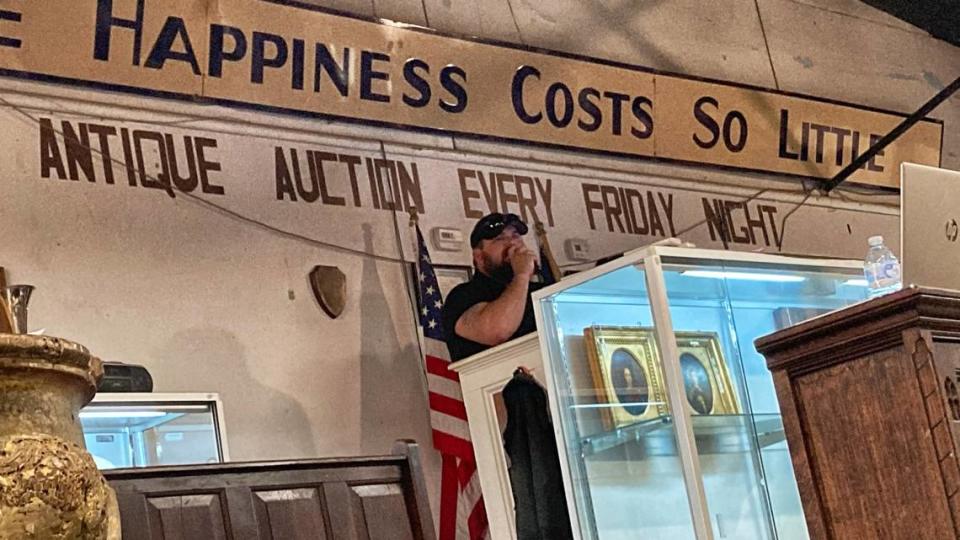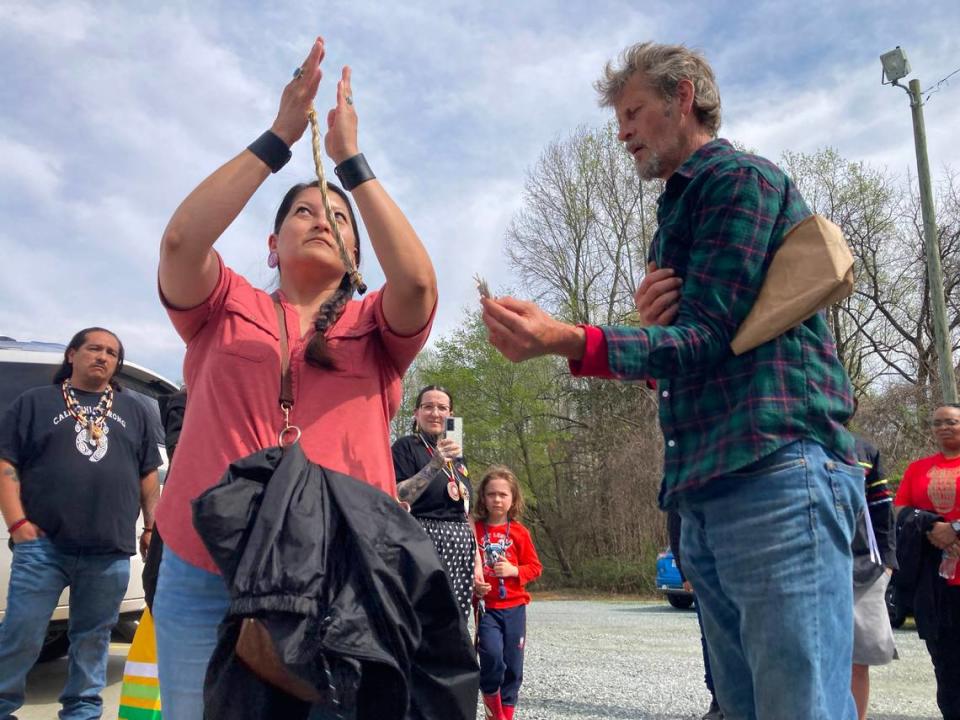Native Americans protest, derail sale of human skull at North Carolina auction house
An effort to sell a 600-year-old human skull at a rural North Carolina auction house was abruptly halted over the weekend after a group of opponents led by Native Americans intervened.
Bidders gathered at the Mebane Antique Auction Gallery in western Orange County on Saturday for the sale of nearly 500 estate items, from age-worn oil paintings to 19th century American rifles.
The small skull — marked Lot 243 in the auction — “appears to be complete and original, missing some teeth,” according to the listing, which dated its previous purchase to an antique gallery in Montreal sometime in the 1960s.
Prospective buyers showed interest well before the bones, described as originating in North America circa 1400, were slated for the auction block. By mid-day Saturday, more than a dozen online bids had pushed the price up to about $2,000.
But the skull doesn’t appear destined to end up in private hands.
The owners, a couple in Chapel Hill, told The News & Observer Sunday they want to work with tribal members to repatriate the remains.
The canceled auction is just one example of a long, emotional quest by tribal and federal officials to stop the buying and selling of native human remains.
The successful return of these bones to tribal lands depends largely on a cobbled-together collection of state and federal laws — not all of which are well understood by local law enforcement.
And sometimes, the case in Mebane shows, that patchwork can fail.
Legal or not?
Efforts to stop the auction began days earlier, when Greensboro-based archaeologist Shawn Patch saw the listing. “Offended and insulted,” he raised concerns with the North Carolina Office of State Archaeology, he said.

Michele Walker, spokesperson for the N.C. Department of Cultural Resources, confirmed that the agency learned about the sale of the skull last week and notified law enforcement.
Mebane Antique Auction Gallery , owner Jon Lambert said he fielded calls earlier in the week from the Orange County Sheriff’s Office, which told him the skull was legal to sell.
“We did look into the matter,” Alicia Stemper, spokesperson for the sheriff’s office, said. “Our investigator consulted with the DA last week and also reached out to federal entities. We learned from them that the sale of the skull in question would not violate either N.C. or federal law.”
State law, Stemper said in an email, prohibits the removal of skeletal remains from unmarked graves in North Carolina after October 1981, well after the skull was originally acquired.
“Additionally, there is no indication, nor is there any way to prove, that the skull is from North Carolina,” she said, adding that while the sheriff’s office investigates state crimes, her department did pass information on the auction to the FBI in Charlotte.
Stemper referenced the federal Native American Graves Protection and Repatriation Act, which prohibits the sale and purchase of “the human remains of a Native American.”
“Keep in mind, however, NAGPRA applies to items excavated or discovered on federal or tribal land after November 16, 1990,” Stemper said.
That interpretation is wrong, experts say.
“It doesn’t matter when they’re excavated,” said Stephen Davis, associate director emeritus of the Research Laboratories of Archaeology at UNC Chapel Hill. “In a lot of states, it’s legal to sell human remains. But Native American human remains are excepted from that policy.”
Carrie Wilson, NAGPRA director for the Quapaw Tribe of Oklahoma, agreed. If they’re Native American remains “and they’re being sold today, the law applies to them today,” she said in a phone interview with the N&O Saturday.
Estate sale goes viral
By Friday morning, Patch was surprised to find the listing for the skull still active. And with potential law enforcement avenues to remove it exhausted, he and a colleague reached out to several Native American tribal contacts in the state.
“It was really the eleventh hour,” Patch said in an interview at the auction Saturday. “We would have reached out sooner had we known it would have gotten this far. As of Monday, I didn’t expect we’d be here.”
By the time Crystal Cavalier-Keck, a member of the Occaneechi band of the Saponi Nation, caught wind of the sale Friday afternoon, she was nearing the end of her trip to a United Nations water conference in New York.
She said she called the auction house late Friday and no one answered. So she turned to social media for help.
Her first TikTok video about her opposition to the sale posted around 4 p.m., hours before she arrived back to her home in Mebane.
“I stayed up until 4, just contacting people, emailing people. I was emailing people on the plane. Just trying to figure out what to do,” said Cavalier-Keck, a member of the state-recognized Occaneechi band of the Saponi Nation. “I was really hoping the TikTok would go viral — that somebody would respond.”
And respond they did.

By the time the Mebane auction house opened Saturday, friends and relatives from at least a half-dozen tribal affiliations arrived at the 13,000-square-foot warehouse just off U.S. Highway 70, where the skull sat entombed in a glass display case just beneath the chanting auctioneer.
To Cavalier-Keck, the bones appeared to belong to a little girl. “Just from the size of the skull, it just looks like a child,” she said. “A young, small woman.”
Word got around to other tribes as well.
In an email to the auction house at 12:30 p.m., an attorney with the Sappony, one of the state-recognized American Indian tribes, demanded the sale stop immediately.
“The Tribe believes Mebane Antique Auction Gallery’s possession of these remains is unlawful and any sale of these remains is illegal,” Marion Werkheiser, an attorney for the tribe, wrote.
Protest cancels auction of skull
Nearly five hours after the start of the auction Saturday, gallery owner Jon Lambert told members of the group of Native Americans and their allies standing along the sidelines of the warehouse that the skull — still front and center in its lit display — would not be sold.
After Lambert announced the decision publicly over the loudspeaker, emotions peaked. Protests halted the rapid-fire rattle of auctioneers.
Tribal members pleaded to cover the skull, to honor it as “our ancestors would like.” Their request was initially denied.
“You’ve been holding onto this thing for way too long,” Jason Keck, Crystal’s husband, shouted. “You’ve been not listening to your heart. You’ve been not listening to your spirit. You’ve been not listening to your humanity.”
He called Lambert a “coward” and a “capitalist,” and told the crowd they should be ashamed.
As the sales resumed, the chant of the auctioneer clashed with the trill of one Native American woman’s “lele” cry.
Within minutes, the gallery relented. An employee removed the skull from the case and carried it to the back of the room, its lot tag still dangling. Cavalier-Keck and other tribal members packed its open sockets with sage before wrapping it with a green woven blanket.
“I’m so sorry this happened,” the auction employee said.
Cavalier-Keck laid her hand on his shoulder. “She was a child,” she said, in a voice barely above a whisper.
In a phone interview with the N&O Sunday, Lambert criticized protesters for “trying to get attention” instead of coming to him earlier in the week with their concerns, calling their actions “sad.”
In his 30-plus years of running the auction, he said he’d never had a disruption like Saturday’s. He would have allowed experts to examine the skull in advance, he said. But aside from the questions he answered from law enforcement, no one asked.
“The only reason I took it out of the sale yesterday is to satisfy these crazies,” Lambert said Sunday.
He said he understood the skull to be a museum piece, based on apparent markings and labels along one side — “VRDR-1” and “SK-7” written in thick black ink.
“I’m not in the human-remains business,” Lambert said. “If I was in an estate and saw a skull with no markings on it, I think I would run away from it. That’s when you’re walking on thin ice.”
He also raised doubts about the skull’s authenticity after he said he received a call late Saturday from someone telling him it could be a replica.
“At the end of the day, the skull’s not sold and is going back to the family – and we don’t even know if it’s real or not,” Lambert said.
Davis, the UNC archaeologist, said it doesn’t look like a replica. In the 1960s, he said, most replicas were done in heavy plaster — with technology not delicate enough to preserve the patterns present in photos of the skull he reviewed.
The skull’s owners think it’s real too.
“I would be shocked if it were a replica,” Lee Walker, of Chapel Hill, told the N&O in an interview Sunday. “If it were a replica, I wouldn’t have bought it.”
He said he bought the skull in the late 1960s as a young man recently out of the Army. He majored in anthropology and archaeology, and it caught his interest as he browsed a Montreal shop called the Petit Musee.
When he brought it back to the U.S., he said “the customs people looked at it and had no problem with it.”
It’s been in his possession since he bought it, but he said he was never able to figure out where it originated. He and his wife consigned it for sale through the Mebane auction house while in the process of downsizing their home.
But after learning of the concerns of tribal members at the auction Saturday, they said they were interested in donating it properly to ensure it got into the right hands.
“I have no problem working with anyone looking to repatriate it to wherever it should be,” Walker said.
At auction, relief over decision not to sell
Before the skull was whisked from the auction room Saturday, members of the crowd made protests of their own.
Someone accused tribal members of “showing off.” Another asked why they hadn’t raised the issue sooner.
“We tried,” Cavalier-Keck responded. “We tried.”
In a brief verbal confrontation with one of the people opposing the skull’s sale, a man in the audience motioned to himself and his wife: “We can afford to be here. Can you?”
But as the tribal members regrouped outside, a tall man holding a dog exited the auction house to tell them he respected what they did. He was there to look at a car, he said, and was moved by their actions.
“Regardless of what anybody said, I think y’all did the right thing,” the man said.
In the parking lot, the group absorbed the emotional partial victory
“This could be my grandmother or your grandmother,” Randy Newcomb told a pair of reporters, wiping away tears. “This was stolen. It’s not appropriate.”
Jason Keck admitted that his emotions got the best of him inside.
“I have a want to educate individuals like that they’re still human, they’re just disconnected from their heart. They’re disconnected from their spirit,” Keck said. “And they depend on rights, this thing we’ve come to be dependent on, over responsibilities.”
As Cavalier-Keck tallied the tribal membership in the lot – Sappony, Choctaw, Catawba, Yaqui, Tuscarora, Assiniboine – TyAnn Nakai, a U.S. Marine veteran and Diné tribal member, said they didn’t need to know where the bones originated to show up for them.
“It’s still part of us,” Nakai said.
Regardless of whether the crowd agreed with them, it was important to be visible, she said.
“They see us, we’re still here and we’re going to continue to fight for what’s right and make them hear us,” Nakai said. “Some people might not like that we’re here. But we’re here, and we’re going to continue to be here.”

